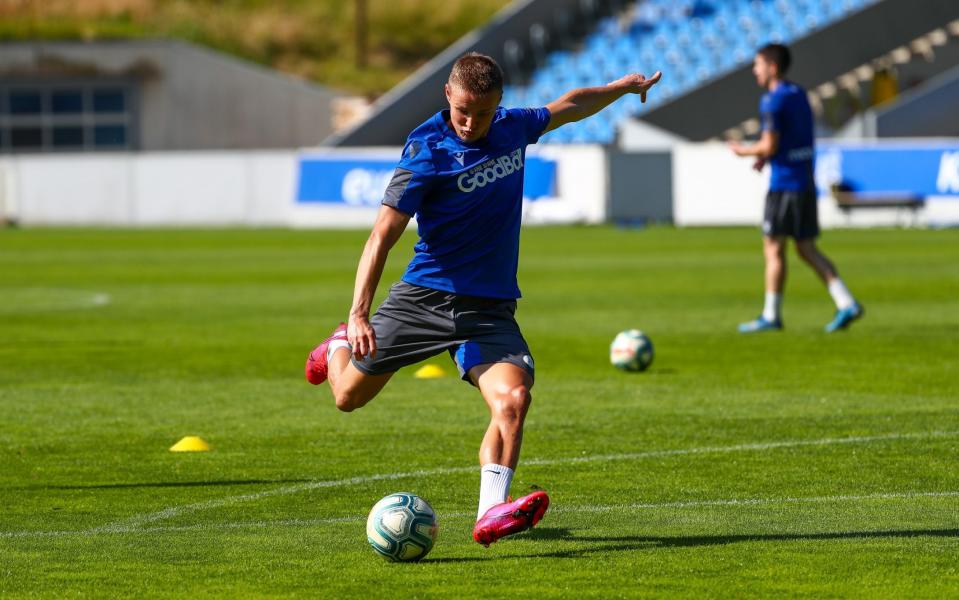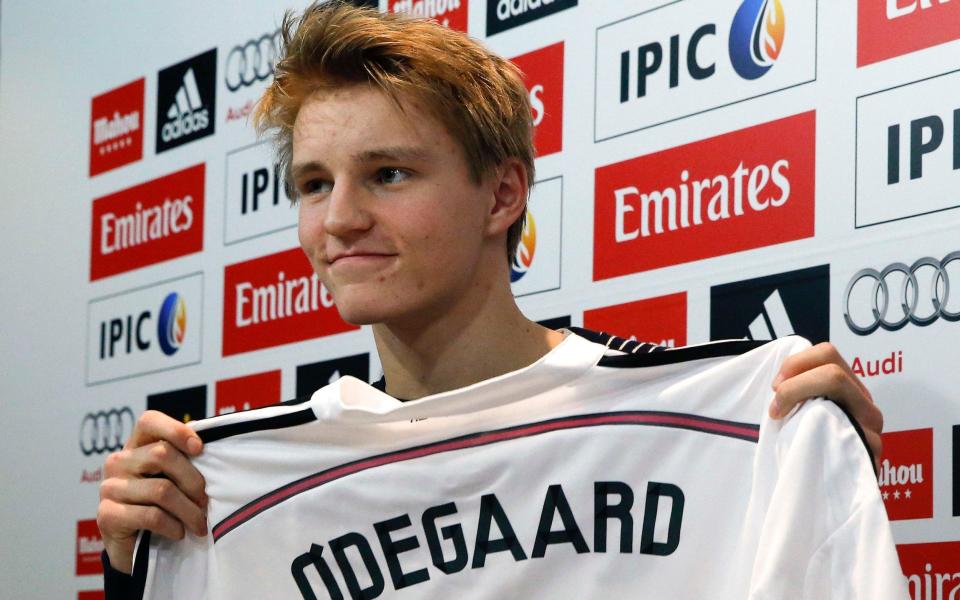The second coming of Martin Odegaard: how teen prodigy is fulfilling 'crazy' expectations

You would not think it, given his polite exterior and baby-faced features, but there is an angry side to Martin Odegaard. It is an aggression that simmers somewhere beneath the composed Scandinavian surface, waiting to burst out and transform the performances of one of modern football’s most fascinating prodigies.
“When he was angry, he was strong,” says Johnny Jansen, Odegaard’s former coach at Heerenveen. “When he was angry, he was fast. I would fight with him. I would tell him in an aggressive way: ‘Martin, you have to play quicker, you have to move quicker.’ I asked for more from him. Again and again and again. He was sometimes frustrated with me but that was good — then you saw his character. He said to me: ‘I need it, I need it.’”
At that stage of his career, aged 18, Odegaard had every reason to nurture a sense of frustration. His move to Heerenveen was his first loan from Real Madrid, the club who had won the much-publicised race for his signature when he was just 16 years old, and by then the sneering had already begun.

At Madrid he had made just one league appearance for the first team and, for those who were expecting "the next Lionel Messi", it did not take long for him to be branded a flop. Was this kid not supposed to be the best of his generation? Where were the tricks, goals and assists? And what was he doing moving to a mid-table side in the Dutch Eredivisie?
“When we first heard he was joining Heerenveen, everyone was thinking: ‘Martin Odegaard? THE Martin Odegaard?’ But he was just Martin,” Jansen, then an assistant and now the club’s head coach, tells Telegraph Sport. “He was one of the guys, interested in the other players and the staff.
“He did not say a lot, because he is a quiet guy. But when he said something about football, it had an impact. It had quality. You could see he knew a lot more than other guys at that age. In his face you could see a boy, but when you talked with him about football you could see a man.”
Three years later, that man has surfaced for the world to see. Odegaard is yet to make his second appearance in the league for Real Madrid but, at the age of 21, he is justifying the hype with his performances for Real Sociedad, who return to action this weekend. Such has been the success of this latest loan move that Odegaard is, statistically speaking, the most creative player on Real Madrid’s books.
“At the moment he is a player on a top, top level,” says Stefan Johansen, the Fulham midfielder and Odegaard’s international team-mate with Norway. “Every time I see him he gets better and better. He is so mature in the way he plays. He never loses the ball and he makes good decisions on when to take risks and when to make game flow.”
The temptation is to view Odegaard’s journey through the prism of the child prodigy who somehow lost his way and then rediscovered his talent. It is certainly an appealing narrative arc. The counterargument, though, is that Odegaard’s rise, fall and rise again is as much a story about the impatience of modern football as it is a tale of one talented player.
“Sometimes people have expected too much from him because of the hype that he got,” Johansen tells Telegraph Sport. Odegaard himself has said there was “too much attention, too positive” when he emerged in Norway at 15, and “a lot of negative, too negative” coverage in those early years at Madrid. “It is a little bit crazy,” he told TV2 last year.
As a child — and he really was a child — Odegaard was one of football’s first genuine internet sensations. The whole world was aware of his ability because the whole world could see it. There it was, right in front of our eyes on YouTube, in highlights from his appearances for Stromsgodset. The nutmegs, the spins, the backheels. With each touch there became more excitement and more desire for Odegaard to play immediately in the biggest leagues.
An international debut at just 15 years and 253 days added to the gathering sense of expectation. The Norway manager at the time was Per-Mathias Hogmo, who saw enough stability in Odegaard’s personal life to convince him that international football would not be too big a step for a boy who was still more than two years away from being able to buy himself a celebratory pint.
“Martin had a very close family, with his father [former player Hans Erik Odegaard] taking away all the pressure around him,” Hogmo tells Telegraph Sport. “So Martin was able to focus on what he is best at. That has been the main reason why he has succeeded. Of course, there were people thinking he should go very fast. But the people around him knew it would take time and that it was a learning process.”
Still, it was hard not to get carried away when he first arrived on the international scene. “He was a smiling young footballer coming in, not afraid of anything,” says Hogmo. “I saw that mental toughness. After one minute in his first game, he dribbled past two players and played a brilliant pass. That is what I see when I think about Martin.”
Those passes, slicing through defences, are the most alluring part of Odegaard’s game. “His through balls,” sighs Jansen. “Ahh, so magnificent. Such quality. He would open up and play the ball that nobody saw. He was so natural in that.”
This season, the best demonstration of Odegaard’s passing ability came in a match against Alaves. He slipped the ball between the legs of one defender, then slid it between four opponents for team-mate Mikel Oyarzabal to score. “Maybe my best assist ever,” he said afterwards with a smile. “It made me happy.”
😱💫 Ødegaard's assist from last night was RIDICULOUS, for those who haven't seen it yet...@martinio98 💙 @RealSociedadEN pic.twitter.com/klSn33IFMT
— LaLiga English (@LaLigaEN) September 27, 2019
Happiness has not always come easy. His first few months at Heerenveen were tough, having to adapt to a different style of football, but he soon found his feet. In the 2018-19 season he moved on loan to Vitesse Arnhem, which is where the explosion began. In all there were 33 starts, nine goals and 12 assists, while he was the only player outside of PSV and Ajax to be named in the Eredivisie team of the season.
At this point, Odegaard was finally flying under the radar, at least by his standards. Other wonderkids were popping up, other prodigies grabbing the world’s attention. Odegaard needed time and patience but until then the modern footballing world had largely starved him of it. It was only when he faded slightly from the global gaze that he truly began to develop.
His performances in La Liga have inevitably thrust him back into the spotlight. He appears more ready for it now, not least in a physical sense. Odegaard has a personal trainer to supplement his work at the club and the transformation of his frame — now all rippling muscles and bulging veins — underlines how the boy has become a man.
Not our day yesterday... We’ll bounce back. #Aupareal 💙⚪️
A post shared by Martin Ødegaard (@odegaard.98) on Aug 31, 2019 at 3:04pm PDT
“I feel like I am playing like more of an adult now,” he told ESPN last year. “I feel like I am creating more, running more, feeling stronger on the pitch. I feel like it is part of growing up.”
The reports in Spain are that Madrid want him back from loan sooner rather than later, especially after he scored against them in the Copa del Rey in February. His agreement with Sociedad is for two years, but there are more than a few observers in the Spanish capital who think he could transform Madrid’s attack next season.
When he does return to Madrid, be it this year or next, it will mark the completion of a journey that has taken far longer than many expected. But those who know him were always confident that, with patience, his moment would arrive. “He always makes the next step,” says Jansen. “He adapts every time.”

